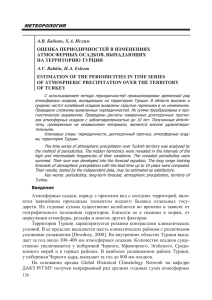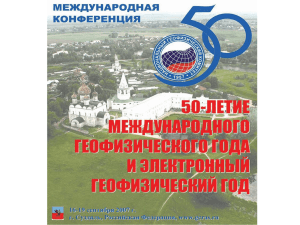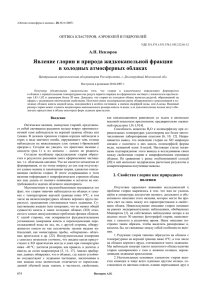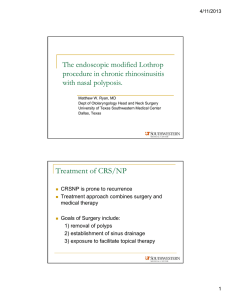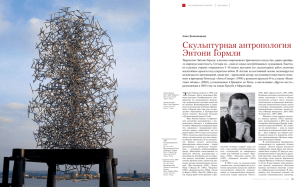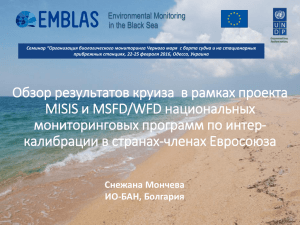extreme precipitation
advertisement

Natural risk assessment laboratory faculty of geography, Moscow State University, Moscow, Russia Large-scale predictors of extreme precipitation in the coastal natural economic zones of European part of Russia Gushchina Daria, Matveeva Tatiana Motivation The special attention drawn to the extreme rainfall is caused by the damage they present for the economics and society: strongest floods, mud torrents, land slips, avalanches etc. • the climate changes involve change of precipitation amount • the trends of precipitation amounts are not always consistent with the changes of extreme rainfall occurrence Problem : Possible solution ! Models fairly reproduce extreme rainfall Estimate the probability of extreme rainfall using indirect indicators Important: indicators may include the characteristics reliably reproduced be the GCMs (air temperature, sea level pressure, geopotential heights) Purpose Assess the change of extreme precipitation occurrence in the warming climate using large-scale synoptical indicators Objectives Step 1: Define the threshold of extreme precipitation for observation and model data Step 2: Emerge the reliable indicators of large-scale extreme precipitation Step 3: Validate the climate model skill in simulation of these indicators Step 4: Assess the extreme precipitation risk change in a warming climate Coastal regions Murmansk region Pechora region Black Sea Coast Data Archive of meteorological observation NCEP/NCAR Reanalysis 17 vertical levels, grid 2.5 ° x 2.5° Climate model GFDL-ESM2M (The Geophysical Fluid Dynamics Laboratory) 24 vertical levels, grid 2.5 ° x 2.0 ° Model participates in the Coupled Model Intercomparison Project Phase 5 (CMIP5). Experiments used: • For model validation – «historical» scenario (preindustrial concentration of CO2) • For global warming condition –– RCP8.5 scenario Major problems in the study of extreme precipitation Complex spatial structure of rainfall fields Lack of uniform definition of the term “extreme precipitation” The measure of extreme precipitation Maximal value for the year or the season (RX1day, RX5day) Precipitation amount larger than 95th or 99th percentile of their distribution (R95p), (R99p) The number of days exceeding the threshold value (R10, R20) The duration of periods when precipitation is larger than the threshold (CDD, CWD) Our approach Criteria of the dangerous hydrometeorological phenomena used by the Russian Hydrometeorological service Phenomenon Rainfall Period Very heavy rain ≥50 mm 12 hours Very heavy snow ≥20 mm 12 hours Problem: Different criteria for solid and liquid precipitation It is impossible to use the uniform threshold Possible solution Method to determine precipitation types - partial thickness methods If < 1540 м, < 1310 м Layer temperature is below freezing Snow falls Algorithm for extreme precipitation threshold definition in the model The model is not capable to simulated the real local rainfall extremes Need to coincide the model and observation data Compose the representative data samples (less than 10% missing data [Zolina et al., 2006]) Obtain the empirical functions of distribution Find the theoretical approximation of empirical distribution The best consistence - Weibull distribution x – sample unit, F(x) – probability obtained by the empirical cumulative distribution observation model Find the percentile corresponding to the threshold of 50 mm and 20 mm in the theoretical distribution for observation Define the threshold for model data as corresponding to this percentile Precipitation in observation 50 mm (rain) 20 mm (snow) Precipitation in model data Murmansk Pechora region region Warm period 32.2 mm 30.4 mm Cold period 19.4 mm 18.2 mm Black Sea Coast Summer Winter 28.5 mm 36.3 mm Winter 16.2 mm Evaluation of extreme precipitation indicators The structure of baric field EOF-analysis of sea level pressure for the extreme precipitation days > 90% of the variability of the pressure field Evaluation of extreme precipitation indicators summer winter The structure of baric field Evaluation of extreme precipitation indicators ! Baric structure is not a sufficient indicator of extreme precipitation Precipitation Frontal Indicators of frontal zone The simplest - the horizontal temperature gradient at 850 hPa exceeding some threshold : In the Black Sea coast – 70-80% of days with extreme precipitation are associated to this indicator Use of this threshold indicator is reliable For the coastal zone of the Arctic – 30-40% Requirement of other indicator of frontal zone Non-frontal Indicators include moisture characteristics, fairly simulated by the climate models For the moment we don't consider these extreme precipitation Indicators of frontal zone . (for the coastal zone of Arctic) Most informative is frontal parameter F [Shakina et al.] F=P+ψ Includes surface temperature gradient ! on the Arctic coastal zone strong temperature contrast during the days with extreme precipitation is not observed Calculation of the P parameter is not informative Includes gradient of equivalent thickness as a measure of baroclinity Frontal parameter ψ The area where the gradient of baroclinity has an extreme in the direction of a layer thickness gradient, should be identified as the front. in the layer 850-1000 hPa, in conventional unit Murmansk Pechora the majority of days with extreme precipitation are associated with ψ maximum the ψ may serve as indicator of the frontal zone (for the Arctic coastal region) The threshold for the frontal parameter ψ threshold ψ=16 Daily precipitation, mm The problem of "dry" fronts on the Arctic coast Air temperature at 2 m at 850 hPa An additional constraint on the temperature Large-scale Indicators of extreme precipitation Black Sea coast structure of the pressure field + the horizontal temperature gradient Arctic coastal region structure of the pressure field + the frontal parameter ψ + constraint on the temperature Model validation The structure of the pressure field NCEP/NCAR reanalysis Climate model GFDL-ESM2M The model successfully reproduces the main pressure patterns associated to the extreme precipitation events Validation of the model Frontal parameter ψ The maximum of ψ in GFDL are located in the region of extreme precipitation threshold ψ=16 Daily precipitation, mm The model successfully reproduces the frontal parameter ψ maximum and distribution for the days with extreme precipitation Occurrence of indicators of extreme precipitation Region 1971-1990 2046-2065 2081-2100 Conditions Winter Black Sea Coast 173 169 (-2.3%) 175 (+1.1%) Structure of the pressure field + Frontal zone Summer 122 115 (-5.7%) 129 (+5.7%) Structure of the pressure field + Frontal zone Cold season Murmansk region Pechora region 139 136 (-2.2%) 145 (+4.3%) Structure of the pressure field + Frontal zone 118 132(+11.9%) 123 (+4.2%) + Constraint of the temperature Warm season Murmansk region Pechora region 68 65 (-4.4%) 67 (-1.4%) 81 83 (+2.5) 80 (-1.2%) Structure of the pressure field + Frontal zone Main achievements The threshold of extreme precipitation was defined for observation and climate model GFDL-ESM2M for the Black Sea and Arctic coastal zones of European Russia. The most appropriate indicators of large-scale precipitation extremes were emerged, particularly: pressure field structure and intensity of frontal zone The skill of the GFDL-ESM2M model in simulation the precipitation extreme indicators are demonstrated The changes of precipitation extremes risks under global warming condition are estimated : we do not expect dramatic changes of the risk of extreme frontal precipitation in the Black Sea Coast and the Arctic coastal region during XXI century. Discussion and perspectives The last results does not mean that we have no suspicion about floods increasing in future as they may result from other reason Our key message – we do not observe the drastic changes of conditions favorable for precipitation extremes of frontal genesis. To extend our conclusions we need Include convective precipitation in the assessment pass from traditional approach to extreme measurements (days with heavy rain) to duration of wet period (talk of Zolina Olga) Thank you for your attention Additional Интенсивная ВФЗ в дни в экстремальными осадками Зима Холодный период Лето Тёплый период Согласно этому алгоритму, тип осадков предлагается определять по данным о высоте поверхностей 1000, 850 и 700 гПа: •снег выпадает, если толщина слоя 850–700 гПа < 1540 м и толщина слоя 1000-850 < 1290 м; •дождь выпадает, если толщина слоя 1000–850 гПа > 1310 м; • смешанные осадки выпадают, если толщина слоя 850–700 гПа лежит в интервале 1540–1560 м, а толщина слоя 1000–850 гПа – в интервале 1290-1310 м. Кавказ 2w N 0 ( w) f 2div (Q) 2 z 2 2 u v v u g ~ v g ~ u g f g g g g Q1 0 y x x x x z x z ~ ~ u g v g v g u g g u g v g Q2 f y x y y y z y z 0 Холодный период Арктика Теплый период Арктика ЧПК Повторяемость случаев превышения порогового значения горизонтального градиента температуры на 850 гПа в дни с экстремальными осадками Регион Период Регион Мурманска Регион Печоры Холодный период 39% 37% Теплый период 26% 24% 1971-1990 2046-2065 2081-2100 Условия Зима 752 762 (+1.3%) 724 (-3.7%) 562 546 (-2.8%) 559 (-0.5%) 173 169 (-2.3%) 175 (+1.1%) Барическое поле Фронтальная зона Барическое поле + Фронтальная зона Лето 1102 1086 (-1.5%) 1093 (-0.8%) Барическое поле 415 433 (+4.3%) 442 (+6.5%) Фронтальная зона 129 (+5.7) Барическое поле + Фронтальная зона 122 115 (-5.7%) 1971-1990 2046-2065 Условия 2081-2100 Холодный сезон 985 996 (+1.1%) 1072 (+8.8%) Барическое поле 379 353 (-6.8%) 357 (-5.8%) Фронтальная зона 145 (+4.3%) Барическое поле + Фронтальная зона + Ограничение по температуре 139 136 (-2.2%) Мурманск Теплый сезон 654 611 (-6.6%) 646 (-1.2%) Барическое поле 203 189 (-6.9%) 194 (-4.4%) Фронтальная зона 67 (-1.4%) Барическое поле + Фронтальная зона 68 65 (-4.4%) 1971-1990 2046-2065 2081-2100 Условия Холодный сезон Печора 852 820 (-3.8%) 874 (+2.6%) Барическое поле 332 346 (+4.2%) 319 (-3.6%) Фронтальная зона 123 (+4.2%) Барическое поле + Фронтальная зона + Ограничение по температуре 118 132 (+11.9%) Теплый сезон 591 604 (+2.1%) 608 (+2.9%) Барическое поле 173 181 (+4.6%) 179 (+3.5%) Фронтальная зона 80 (-1.2%) Барическое поле + Фронтальная зона 81 83 (+2.5)
